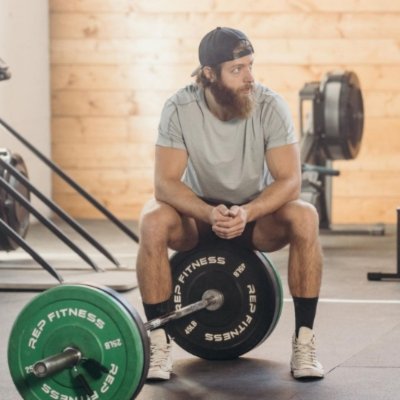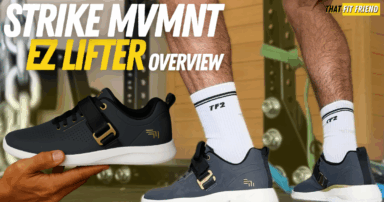Whether you’re a strength athlete, recreational lifter, or sports athlete, it’s never a bad idea to do more single-leg training. Single-leg training can have a ton of benefits across all realms of life.
And when we think of single-leg training, our minds often go to things like lunges and split squats. However, single-leg training comes in multiple forms and the single-leg deadlift is a slept-on exercise, in my opinion.
The single-leg deadlift can be great for training your hamstrings and glutes while improving strength and stability. Remember, this exercise is a skill and it may take a few weeks to learn and be proficient at.
Single-Leg Deadlift Proper Form
In this single-leg deadlift guide, I work with my friend and fellow strength coach Alec Blenis to cover proper single-leg deadlift form, mistakes to avoid, and the benefits of performing them.
Single-Leg Deadlift Muscles Worked
When it comes to the muscles the single-leg deadlift works, you’re going to have a lot of carryover between this variation and the traditional deadlift in the context of what muscles you’re training.
The one difference that most lifters typically feel with the single-leg deadlift is that with the additional internal and external rotation the hips work through you’ll typically feel your glutes a lot on the planted leg with this variation.
The reason lifters will often “feel” their glutes more with single-leg deadlifts is because the hips are working through multiple ranges of motion during this exercise.
For the descent, the hips are flexing, adducting, and internally rotating, then during the ascent the hips are doing the opposite so they’re extending, abducting, and externally rotating all of which the glutes play a role in.
Single-Leg Deadlift Mistakes
When you’re just starting out on your single-leg deadlift journey you’ll want to make sure you’re working to be proficient in this skill and not falling victim to some of the most common single-leg deadlift mistakes.
Mistake 1: Helicoptering the Weight
The first mistake that lifters often make with single-leg deadlifts is “helicoptering” the weight. This essentially means letting the weight and barbell completely pull you out of position when locking out your lift.
When doing single-leg deadlifts, it’s normal to experience a small degree of rotation, especially during the learning stages of this exercise but if you like you’re “spinning out” at the top then you likely need to lock down your mechanics a little more.
The Fix: If this is happening to you, then you’ll want to either drop the weight on the barbell that you’re using to focus on keeping a better bar path or you’ll want to make more of an effort to keep your hips square throughout reps.
Oftentimes this issue arises due to the lack of limiting the external rotation and internal rotation that the hip is moving through in tandem with the weight, so if you can own your hip position better then you’ll prevent spinning out.
Mistake 2: Opening the Hips Too Much
Another mistake that lifters often make when learning the single-leg deadlift is opening the hips too much. This is usually a result of not feeling “comfortable” when bending down to get in position and grab the barbell.
When you open the hips to a large extent you’re going to take away work from your hamstrings, glute max, and glute medius and you’ll be limiting your stability which can impact your proficiency.
The Fix: Before you pick up the barbell look at your floating leg’s hip. If it’s angled towards the sky, then flatten and “feel” the glute stretch on the grounded leg. It should be pretty apparent when you get this position right.
To practice limiting this either drop the weight on the bar to ensure you’re keeping the hips relatively square or utilize a tempo to “feel” out reps to see where you might be opening too much.
Mistake 3: Shifting the Pelvis Too Much
The final mistake that is common to see lifters make is shifting the pelvis too much over the foot. This means that you’re leaning heavily over the grounded foot, so if you were lifting on your left leg then you’d be shifted too far left over that foot.
This is an issue that you’ll usually see arise as the weight on the barbell gets heavier because it can sometimes “feel” more stable to shift our weight more to compensate for balance. It can also be an issue with the feet and how they’re being grounded.
The Fix: Start with your feet and see what the planted foot is doing while you lift. A lot of times lifters will overly grip the floor and keep all of their weight shifted into the lateral side of the foot.
In this context, let the arch collapse and let your foot do its thing naturally to help you stabilize while lifting. A towel or low wedge can be an awesome proprioceptive tool to help facilitate this. Think about pressing into the towel with your arch as you lift.
Single-Leg Deadlift Benefits
Out of all the single-leg exercises that lifters perform on a routine basis, the single-leg deadlift doesn’t typically receive as much attention as something like a Bulgarian split squat but that doesn’t mean it doesn’t come with a lot of benefits.
Benefit 1: Great for Improving Athleticism
The first benefit that I love to talk to lifters and athletes about the single-leg deadlift is that it can be an awesome exercise for improving general athleticism.
Athleticism takes a wide range of forms but anytime you can tie in strength, balance, coordination, and proprioceptive components into one exercise then you can typically assume that an exercise will have some carryover to sport.
The single-leg deadlift can help lifters improve what the posterior muscles are doing when in situations where balance is limited. We usually give a lot of love to the quads and anterior leg muscles when focusing on single-leg work but the posterior muscles need love, too.
On top of this, the single-leg deadlift can teach better pelvis control and positioning which is key for most athletic endeavors as the hips dictate a lot when moving forward, backward, sideways, and with speed and power.
Benefit 2: Awesome for Building the Glutes and Hamstrings
The single-leg deadlift is unique because it’s going to train the hips through a lot of different movement patterns during the descent and ascent of reps. As a reminder, the hips do the following during reps.
- Decent: Flexion, adduction, and internal rotation
- Ascent: Extension, abduction, and external rotation
The glute max and glute medius will play shifting roles in all of these movement patterns and the hamstrings will also be active to help control your eccentric and to assist with stabilizing the pelvis.
When performed with good mechanics, single-leg deadlifts regularly blow my glutes up just as much as Bulgarian split squats. If you’re looking for an exercise to train your glutes and hamstrings, the single-leg deadlift can be an awesome variation.
Benefit 3: Improves Single-Leg Strength
The final benefit I want to discuss, which should come as a no-brainer, is that the single-leg deadlift will improve your strength. I alluded to this above, but we typically focus really heavily on the anterior muscles when doing single-leg work.
The single-leg deadlift is great for improving your lower body strength and you’ll also get some stimulus for the back muscles, traps, and forearms as they’ll play a role in helping you stabilize and lift weight.
A fun test to see how your anterior and posterior muscles compare is to perform a few sets of single-leg hamstring curls and extensions on your machines and see where your strength lies on each.
If you find that your leg extensions are a lot stronger than your hamstring curls then your posterior muscles may be lagging a bit and it might be a good idea to program more single-leg deadlifts to bring up your posterior muscles.
Frequently Asked Questions (FAQ)
Q:What muscles do single-leg deadlifts train?
Q:Is single-leg deadlift same as RDL?
Q:What are single-leg deadlifts good for?
Q:Do single-leg deadlifts grow glutes?
Takeaway Thoughts
I’m a strong believer that we could all benefit from more single-leg deadlifts in our lives. To be honest, I think everyone could use more deadlifts in general no matter what variation is being performed.
Single-leg deadlift can be great for improving your athleticism, single-leg strength, and it’s an awesome exercise for blowing up and targeting the glutes.
If you have additional questions about the single-leg deadlift, drop a comment below or on the YouTube video above, or reach out to me via Instagram (@jake_boly or @that_fit_friend).



















Add a Comment